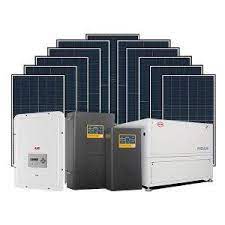Imagine peacefully watching your favorite TV show when the lights suddenly go out, and your screen fades to black, or you are having a nice time with your family, and it gets bad because of a power outage.
Inverters – you might not have given them much thought, but they’re the behind-the-scenes of our modern-day electrified world.
These devices, which we often find in our homes or connected to solar panels, have a knack for turning things around.
In the simplest terms, they transform direct current into the kind of electricity we use daily, alternating current.
We’ll look into the advantages that make our lives more convenient and eco-friendly, but we’ll also shed light on their disadvantages.
So, stay read on as we journey through inverter advantages and disadvantages.
Advantages of Inverters
- Energy Independence
- Solar Power Integration
- Backup Power During Outages
- Energy Efficiency
- Reduced Electricity Bills
- Quiet Operation
- Extended Appliance Life
- Optimized Energy Usage
- Smart Monitoring
- Compatibility
Energy Independence
Inverters pave the way for energy independence, transforming remote areas into vibrant hubs. Imagine a rural village in Africa where solar-powered inverters bring light to homes and power to schools, opening doors to education and progress. It’s not just energy; it’s a lifeline.
Solar Power Integration
Inverters usher in an era where the sun becomes our ally. By converting solar energy into usable electricity, they reduce our reliance on fossil fuels, mitigating climate change while saving us money. It’s the environmental and financial win-win we all need.
Backup Power During Outages
When storms rage and the grid falters, inverters emerge as the saviors, providing backup power. They’re the quiet guardians, ensuring you have light in the darkest hours and can charge your phone when needed.
Energy Efficiency
Inverters are the secret agents of energy efficiency. They optimize power usage, ensuring that every watt counts. From your air conditioner to your refrigerator, they help you save money and reduce your carbon footprint.
Reduced Electricity Bills
Every penny counts, and inverters help you count more pennies in your pocket. Solar power and optimizing energy consumption can significantly reduce monthly electricity bills.
Quiet Operation
Most modern inverters are designed to operate silently, ensuring a peaceful environment in your home. You won’t hear clunky machinery, whether the inverter in your solar panel system or the one powering your backup during an outage.
This means you can enjoy the benefits of uninterrupted power without the accompanying noise.
Extended Appliance Life
Inverters act as guardians of your appliances. By delivering a consistent and stable flow of electricity, they prevent sudden surges and fluctuations that can damage your valuable devices.
This care ensures your appliances have a longer, healthier life, saving you money in the long run.
Optimized Energy Usage
Inverters are like energy coaches, helping you get the most out of every power unit. They manage energy use efficiently, minimizing waste and reducing your energy costs.
With their help, you can make environmentally conscious choices while saving money.
Smart Monitoring
Many inverters come equipped with smart technology, allowing you to monitor and control your energy use from the palm of your hand.
Using your smartphone or computer, you can check your energy production, adjust settings, and even receive alerts about any issues.
This real-time access to your energy data empowers you to make informed decisions about your electricity consumption.
Compatibility
Inverters are incredibly versatile. They play well with various devices, from small gadgets like laptops and smartphones to large appliances like refrigerators.
Their seamless compatibility ensures you can power your daily life without hiccups, making them an essential part of modern living.
Disadvantages of Inverters
- Initial Cost
- Maintenance Requirements
- Grid Dependency
- Environmental Impact
- Compatibility Issues
- Efficiency Loss
- Complex Installation
- Size and Space
- Noisy Cooling Fans
- Potential Overloading
Initial Cost
The upfront cost of purchasing and installing inverters can be bank-breaking. However, before being discouraged, consider the long-term savings and the impact of less carbon activity.
It’s an investment in a brighter, more sustainable future.
Maintenance Requirements
Inverters, like all other gadgets, need care and attention.
Grid Dependency
Grid-tied inverters have a limitation: they rely on a functioning grid. When the power goes out, so does your inverter. Hence, the importance of battery backup systems for uninterrupted power.
Environmental Impact
The production and disposal of inverters come with an environmental cost. Yet, there are ways to mitigate this impact, from responsible recycling to greener alternatives.
Compatibility Issues
Not all devices play well with inverters. Compatibility issues can arise, leaving you scratching your head. We’ll provide insights into these challenges and offer practical tips for addressing compatibility concerns.
Efficiency Loss
Inverters are good but not perfect. They don’t convert 100% of the power they receive. There’s a slight efficiency loss in the conversion process, meaning that a small percentage of the energy generated by your solar panels or stored in your battery may be lost as it’s transformed from DC to AC.
Complex Installation
Large, grid-tied inverters can be complex. They usually require professional installation due to their size and the intricacies of connecting them to the electrical grid.
This complexity can add to the upfront cost of your solar panel system. However, they work seamlessly once installed correctly, providing clean, grid-connected energy.
Size and Space
Inverters are not tiny devices. They can take up significant space using a string inverter, central inverter, or hybrid inverter.
Finding the right spot for your inverter can sometimes be challenging, especially with limited space. However, many modern inverters are designed to be compact and wall-mounted, making the installation process more manageable.
Noisy Cooling Fans
Some larger inverters, particularly those used in commercial or industrial applications, come with cooling fans to prevent overheating.
These fans can produce a low humming or whirring noise. While noise is usually not disruptive, it can be noticeable in quiet environments.
Potential Overloading
Inverters have their limits. Connecting too many solar panels or appliances to an inverter can become overloaded, affecting performance and efficiency.
Following the manufacturer’s guidelines and ensuring that your inverter’s capacity matches your system’s needs is essential to prevent overloading.
Inverters and Their Functions
An inverter is an electronic device that converts direct (DC) electricity into alternating (AC). It essentially “inverts” the flow of electricity, making it suitable for powering most household and industrial appliances.
Inverters are commonly used in solar power systems, backup power supplies, and everyday electronics like laptops and refrigerators.
Inverters Installations
Installing inverters is seemingly possible, but it largely depends on the type and size of the inverter. Nonetheless, a professional can handle this with ease. Here are some key considerations:
- 1. Type of Inverter
Smaller, standalone inverters designed for powering a single appliance or a small system, like a car inverter or a portable solar generator, are often designed for DIY installation. They typically come with user-friendly instructions.
- 2. Solar Inverters
Hiring a professional installer is recommended if you’re considering installing a solar inverter as part of a solar panel system.
Solar installations involve electrical work; safety and compliance with local regulations are paramount. Professionals are trained to ensure the system operates efficiently and safely.
- 3. Grid-tied inverters
Grid-tied inverters connected to the utility grid also require professional installation due to the complexity of the electrical connections and the need to adhere to grid regulations.
- 4. Battery Inverters
For battery-based inverters, especially those connected to a home energy storage system, it’s advisable to consult with or hire a certified electrician or technician. These systems involve working with high-voltage batteries, which can be hazardous if mishandled.
- 5. Safety First
Regardless of the type of inverter, safety should always be a priority. If you’re unfamiliar with electrical work or lack the necessary skills and tools, it’s best to consult a professional to avoid accidents or damage to your equipment.
- 6. Local Regulations
Check local building codes and regulations, as they may dictate who can perform inverter installations. Some jurisdictions require permits and inspections for certain types of installations.
While individuals with basic electrical knowledge can install smaller and simpler inverters, exercising caution and prioritizing safety is crucial.
Inverters and Noise
Inverters are generally quiet, at least not in the same way that many other household appliances or electronic devices can be.
They are designed to operate quietly, making them suitable for residential and commercial settings. However, some factors that could make them noisy are outlined below:
- Fan Noise
Some larger inverters, especially those used for heavy-duty applications like grid-tied solar inverters or industrial systems, may include cooling fans to dissipate heat generated during operation.
These fans can produce a low-level humming or whirring noise. The noise level is typically relatively quiet and shouldn’t be disruptive in most cases.
- Location
The location of the inverter can impact noise perception. If the inverter is installed in a well-ventilated area or an outdoor enclosure, any noise it generates will likely be even less noticeable.
However, if the inverter is installed in a quiet space, like a bedroom or living room, you might be more aware of any noise it produces.
- Inverter Type
The inverter type can also influence noise levels. High-frequency inverters tend to be quieter than their lower-frequency counterparts. Most modern inverters use high-frequency technology for increased efficiency and reduced noise.
- Maintenance
Proper maintenance can help ensure that fans or cooling systems operate efficiently and quietly, which involves keeping the inverter clean when not in use.
- Noise Tolerance
Individual tolerance for noise varies from person to person. What one person perceives as quiet could be bothersome to another.
You should check the manufacturer’s specifications for the expected noise levels and compare them to your comfort threshold.
Models or those used in industrial applications could produce a fan noise instead of regular household inverters.
Inverter with a Solar Panel System
The compatibility between an inverter and a solar panel system is crucial to ensure your solar energy setup’s efficient and safe operation. Here are some key points to keep in mind.
Inverter Types
Different types of inverters are designed for specific solar panel systems. The main types include:
- String Inverters
These are the most common types used in traditional grid-tied solar systems. They’re compatible with a string or series of solar panels wired together. String inverters are typically unsuitable for installations with shading issues, as shading on one panel can affect the entire string’s performance.
- Microinverters
Microinverters are installed on each solar panel, converting the DC power to AC power at the panel level. They are ideal for systems with shading concerns or panels oriented differently. Each panel operates independently, optimizing overall system performance.
- Power Optimizers with Central Inverters
Power optimizers are paired with central inverters. They optimize the DC power at the panel level and then send it to a central inverter for conversion to AC power.
This hybrid system is designed to address shading issues while reducing the cost of microinverters.
- Hybrid Inverters
These are used in hybrid solar systems, including energy storage (batteries). They can manage solar power and battery storage, providing energy during sunny and night hours.
- Voltage and Capacity Compatibility
Besides the type of inverter, it’s essential to consider voltage and capacity compatibility. The inverter should be rated to handle the voltage output of your solar panels and the total capacity (in watts or kilowatts) of your solar array.
Exceeding these limits can result in inefficient operation or damage to the inverter.
- Brand Compatibility
Different inverter manufacturers may have specific compatibility requirements and recommendations for their inverters. It’s advisable to consult the manufacturer’s guidelines and documentation to ensure your solar panels are compatible with the chosen inverter brand and model.
- System Design
The overall design of your solar panel system, including the arrangement of panels, their orientation, and the presence of shading, can affect inverter compatibility. Systems with complex designs or shading issues may benefit from microinverters or power optimizers.
Inverter Lifespans
The lifespan of an inverter can vary depending on several factors, including the type of inverter, the quality of its components, maintenance, and usage conditions. Here’s a general guideline for the expected lifespan of different types of inverters:
- String Inverters
String inverters, commonly used in grid-tied solar panel systems, typically have a lifespan of 10 to 15 years. However, some string inverters can last longer with proper maintenance and favorable environmental conditions.
- Microinverters
Microinverters, installed on individual solar panels, have a longer lifespan than string inverters. They can often last 15 to 20 years or more. Microinverters are less affected by shading issues and are not subject to the same wear and tear as central inverters.
- Power Optimizers with Central Inverters
Power optimizers are devices that can extend the lifespan of central inverters. Central inverters paired with power optimizers can have a lifespan of around 10 to 15 years, similar to standalone string inverters. However, the power optimizers may need replacement during this time frame.
- Hybrid Inverters
Hybrid inverters used in solar systems with battery storage typically have a similar lifespan to string inverters, ranging from 10 to 15 years. The batteries in these systems may have a shorter lifespan, often around 5 to 15 years, depending on the type and quality of the battery.
Several factors can influence the lifespan of an inverter.
The quality and durability of the inverter’s components, such as capacitors and semiconductors, play a significant role. Higher-quality inverters with better components tend to last longer.
Operating Conditions
Inverters operating in harsh environmental conditions, such as extreme heat or humidity, may have a shorter lifespan. Installing inverters in well-ventilated areas and protecting them from excessive temperature fluctuations is essential.
Maintenance
Regular maintenance can extend the life of an inverter. Cleaning and inspecting the inverter, checking for loose connections, and ensuring proper ventilation are essential maintenance tasks.
Overloading
Overloading an inverter by connecting more solar panels than it’s rated can lead to premature failure. It’s crucial to adhere to the manufacturer’s specifications and guidelines.
Electrical Surges and Faults
Electrical surges, lightning strikes, or other electrical faults can damage inverters. Installing surge protectors and proper grounding can help mitigate these risks.
It’s worth noting that inverters can sometimes fail suddenly, but more often, their performance gradually degrades over time. When an inverter nears the end of its life, it may become less efficient, generate less power, or experience more frequent faults.
Inverter Advantages and Disadvantages(FAQs)
1. What’s the difference between a string inverter and a micro inverter?
String inverters connect to a group of solar panels in a row (string), while microinverters attach to each individual solar panel.
String inverters are like one big boss, while microinverters are like a team of little helpers, making each panel work its best.
2. Do I need a battery with my inverter for backup power?
It depends on your needs. Inverters alone won’t give you power during blackouts. If you want backup power, you’ll need a battery system and your inverter, like a superhero sidekick.
3. Can I use an inverter for my car or RV?
Yes, you can! Car inverters plug into your vehicle’s power socket and let you use regular roadside gadgets. RVs often have inverters to make camping life more comfortable.
4. What happens if my inverter stops working?
If your inverter goes on strike, your solar panels won’t be able to power your home. You’ll need to get it fixed or replaced. It’s like calling a doctor for your sick inverter.
5. Are there any safety tips for using inverters?
Yes, safety first! Keep water far from your inverter, and never try to fix it yourself if you’re not an expert. Make sure it’s properly installed and grounded to avoid any electrical shocks.
Conclusion
Having an illuminating experience is possible whereby you never lose touch with light in the world of inverters. However, it is important to note that every technological advancement brings advantages and disadvantages.
Inverters empower us with clean energy, independence, and savings but also require careful consideration and maintenance.
We have detailed in this article the advantages and disadvantages of inverters so you can be properly guided in your decision-making as you seek to explore this path.
Inverter technology is not just about convenience; it’s about shaping a sustainable future.


